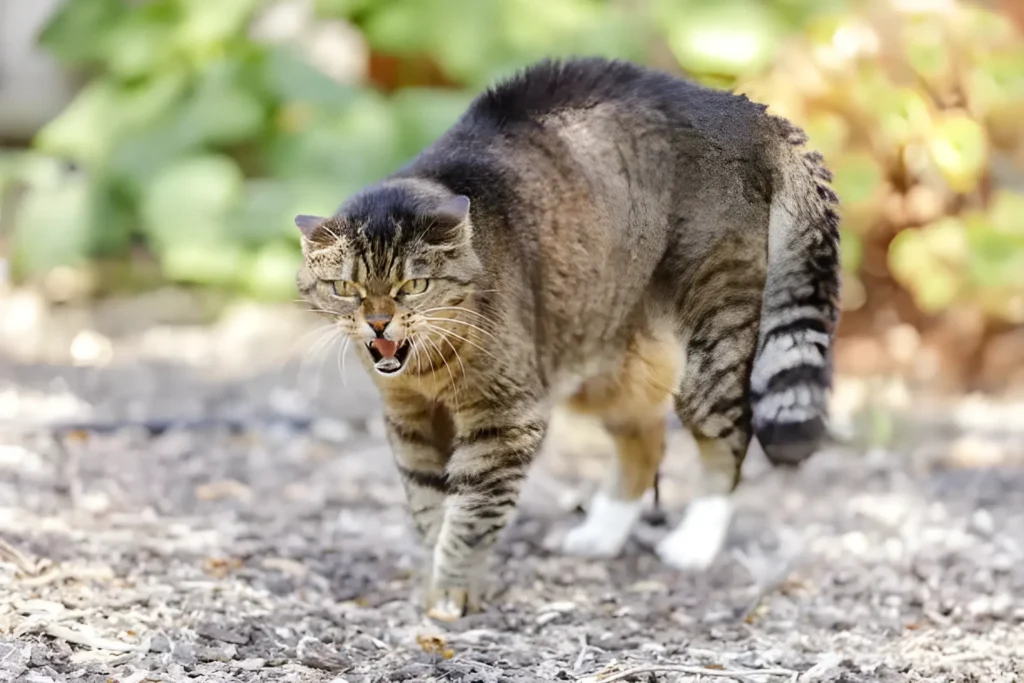Cats are beloved for their independent nature, but sudden aggression can be alarming. If your usually sweet feline has become hostile, there’s likely an underlying reason. The most common culprits are medical issues, environmental stress, and unresolved behavioral problems. Let’s delve into the possible causes and provide guidance on how to help your cat.
Medical Checkup: Ruling Out Pain and Discomfort
Illness: Conditions like arthritis, hyperthyroidism, dental issues, or infections can cause pain and discomfort that manifest as aggression.
Injury: Even a subtle injury from a fall or unseen fight can make your cat lash out.
Neurological Issues: In older cats, cognitive decline or neurological problems can lead to sudden behavioral changes.
Veterinarian Visit: The First Step A thorough examination by your vet is crucial to rule out medical reasons for aggression. Describe specific changes in behavior, even if seemingly unrelated to aggression. Be prepared to discuss your cat’s medical history.
Environmental Stress: Protecting Your Cat’s Peace of Mind
New Additions: Has a new baby, pet, or houseguest joined the family lately? Even positive changes can be stressful for cats.
Construction or Loud Noises: Disruptive work or ongoing loud noises can send an otherwise relaxed cat into high alert.
Territory Disputes: Cats are territorial. Is an outdoor cat or new neighborhood pet threatening your cat’s space?
Tips for Creating a Peaceful Environment:

Create designated safe zones: Provide your cat with comfortable, enclosed hiding spots (like covered cat beds or cardboard boxes with cozy blankets) and high vantage points (cat trees or cleared shelves) where they can feel secure and observe their surroundings.
Maintain a sense of order: A predictable daily schedule, including mealtimes, playtime, and quiet time, reassures your cat and reduces anxiety.
Facilitate gentle introductions: If a new person or animal joins your household, start with short, controlled interactions in a separate room. Let your cat approach at their own pace, and offer plenty of treats and praise for calm behavior.
Behavioral Triggers: Understanding Your Cat’s Reactions
Redirected Aggression: If your cat can’t reach the source of their frustration (like a taunting bird outside), they might redirect aggression towards you or another pet.
Fear-based Aggression: A sudden change in the environment, unfamiliar people, or a frightening experience can make a cat lash out.
Play Misinterpreted: Rough play can sometimes escalate into real aggression. Watch for signs like dilated pupils, ears back, and a stiff tail.
Seeking Expert Help If medical reasons are ruled out and environmental changes aren’t helping, consult a certified cat behaviorist. They can help identify specific triggers and create a behavior modification plan.
Understanding Cat Body Language
| Body Part/Posture | Relaxed | Playful | Fearful | Aggressive |
|---|---|---|---|---|
| Tail | Up, gently curved | Twitching, wiggling, or held high | Tucked between legs or held low | Arched, puffed up |
| Ears | Forward, alert | Forward, may rotate | Flattened against head | Flattened or rotated back |
| Eyes | Soft, may blink slowly | Dilated | Dilated, staring | Narrowed, intense stare |
| Body | Loose, comfortable | May pounce, exaggerated movements | Crouched low, tense | Arched back, fur raised |
Always consider the whole picture. One body signal alone might not tell the full story. Look at your cat’s overall posture and environment for better clues about their mood.
What to Do FIRST: Prioritizing Safety and Understanding
Observe without reacting: Avoid scolding or punishing, which can escalate the situation. Instead, calmly observe your cat’s behavior for clues about their trigger.
Safety for all: If an attack feels imminent, carefully remove yourself, other pets, or vulnerable individuals from the area. Offer your cat a quiet, enclosed space to calm down.
Consult your veterinarian: Describe the aggression in detail to your vet. A checkup is essential to rule out any underlying health issues.
Seek expert help: If your vet clears your cat medically, a certified cat behaviorist can help you pinpoint the cause of the aggression and develop a personalized behavior management plan.
Case Studies: Real-Life Examples
Case 1: Reunited But Not So Happy
Sarah’s usually friendly cat, Mittens, became aggressive towards her after returning from a week-long stay at a boarding facility. The vet found no health concerns. A behaviorist helped Sarah realize the new environment at the boarding facility had stressed Mittens. With gradual reintroduction and creation of a safe space at home, Mittens’ anxiety subsided, and her bond with Sarah returned.
Case 2: Senior Surprise
Max, a normally easygoing 12-year-old cat, started hissing and swatting at his owners. The vet diagnosed early-stage arthritis. Medication and providing softer resting areas helped manage Max’s pain. His aggression subsided as he felt more comfortable.
Conclusion
Sudden aggression in cats is a sign of distress. By understanding the potential causes, seeking veterinary advice, and adjusting your cat’s environment, you can help restore their sense of well-being and your peaceful bond.
The photo featured below the post headline is Credit: Moostocker/istockphoto
I hope you find this post helpful and informative. If Yes’ feel free to share it with your friends!
Frequently Asked Question
My cat suddenly started biting during petting sessions. What’s going on?
This may be petting-induced aggression. Pay close attention to your cat’s signals – hissing, tail twitching, or dilated pupils could mean it’s time to stop.
My cat has always been friendly but now attacks our other pet. Help!
This could be territorial tension or redirected aggression. Try reintroducing your pets slowly, supervise them closely, and provide separate resources (food, water, litter boxes).
Is it possible for an older cat to become aggressive?
Yes, pain from arthritis, cognitive decline, or sensory loss can make senior cats irritable. Consult your vet.
My cat suddenly hisses and growls for no reason. What should I do?
There is always a reason, even if you can’t see it. Observe closely for anything that changed in the environment before the aggression. Schedule a vet visit and consider consulting a behaviorist.
My cat attacks my feet when I walk– is this play or aggression?
It could be either! Watch your cat’s overall body language (see the chart above). Redirect playful energy with suitable toys rather than your feet.
Could a change in my cat’s medication cause sudden aggression?
Yes, some medications can have behavioral side effects. Discuss any recent medication changes with your veterinarian.
Why is my cat aggressive after being groomed?
Grooming can be stressful. Look for signs of physical discomfort, try a different groomer, or consider if your cat needs gentler handling due to age or health issues.
My cat suddenly acts aggressive towards my child. What’s happening?
Children can sometimes unknowingly mishandle cats. Supervise interactions, teach your child proper cat handling, and provide your cat with safe spaces away from kids when needed.
Why is my cat aggressive all of a sudden to my other cat?
This could be due to territorial disputes, changes in the environment, a medical issue in either cat, or redirected aggression. Separate them, consult your vet, and reintroduce them gradually.
Can spaying or neutering help with sudden aggression in cats?
Yes, especially if the aggression is hormone-driven. It’s also important for overall health and reducing unwanted litters.

